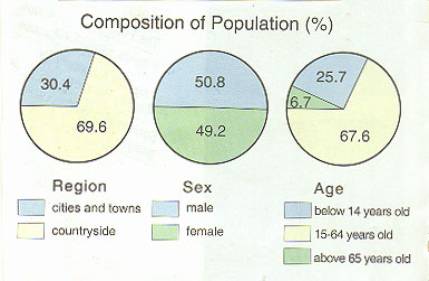|
Population
China
is the most populous country in the world, with 1.25909 billion
people at the end of 1999, about 22 percent of the world??s total.
This figure does not include many Chinese in the Hong Kong Special
Administrative Region, Taiwan Province and Macao Special Administrative
Region.
The
population density in China is 130 people per sq km. This population,
however, is unevenly distributed. Along the densely populated east
coast there are more than 400 people per sq km; in the central areas,
over 200; and in the sparsely populated plateaus in the west there
are less than 10 people per sq km.

The following table gives an overall view of the composition of
the population of China:
Urban/rural
The population in cities and towns makes up 30.4 percent; and that
in rural areas, 69.6 percent.
Sex:
The male population is 50.8 percent; and the female population,
49.2 percent.
Age:
People 14 years or younger make up 25.7 percent; those from 15 to
64, 67.6 percent; and those 65 or older, 6.7 percent.
When
New China was founded in 1949, China had a population of 541.67 million.
Owing to China??s stable society, rapid production development, improvement
of medical and health conditions, insufficient awareness of the importance
of population growth control and shortage of experience, the population
grew rapidly, reaching 806.71 million in 1969. In the early 1970s,
the Chinese government realized that the over-rapid population growth
was harmful to economic and social development, and would cause great
difficulties in the fields of employment, housing, communications
and medical care; and that if China could not effectively check the
over-rapid population growth, and alleviate the tremendous pressure
that the population growth was exerting on land, forests and water
resources, the worsening of the ecology and the environment in the
coming decades would be disastrous, thus endangering the necessary
conditions for the survival of humanity, and sustainable social and
economic development. Then the Chinese government began implementing
a family planning, population control and population quality improvement
policy in accordance with China??s basic conditions of being a large
country with a poor economic foundation, a large population and little
cultivated land, so as to promote the coordinated development of the
economy, society, resources and environment. Since then birth rates
have steadily declined year by year. China??s birth rate dropped from
34.11 per thousand in 1969 to 15.23 per thousand at the end of 1999;
and the natural growth rate decreased from 26.08 per thousand to 8.77
per thousand, thus basically realizing a change in the population
reproduction type to one characterized by low-birth, low-death and
low-increase rates. |



